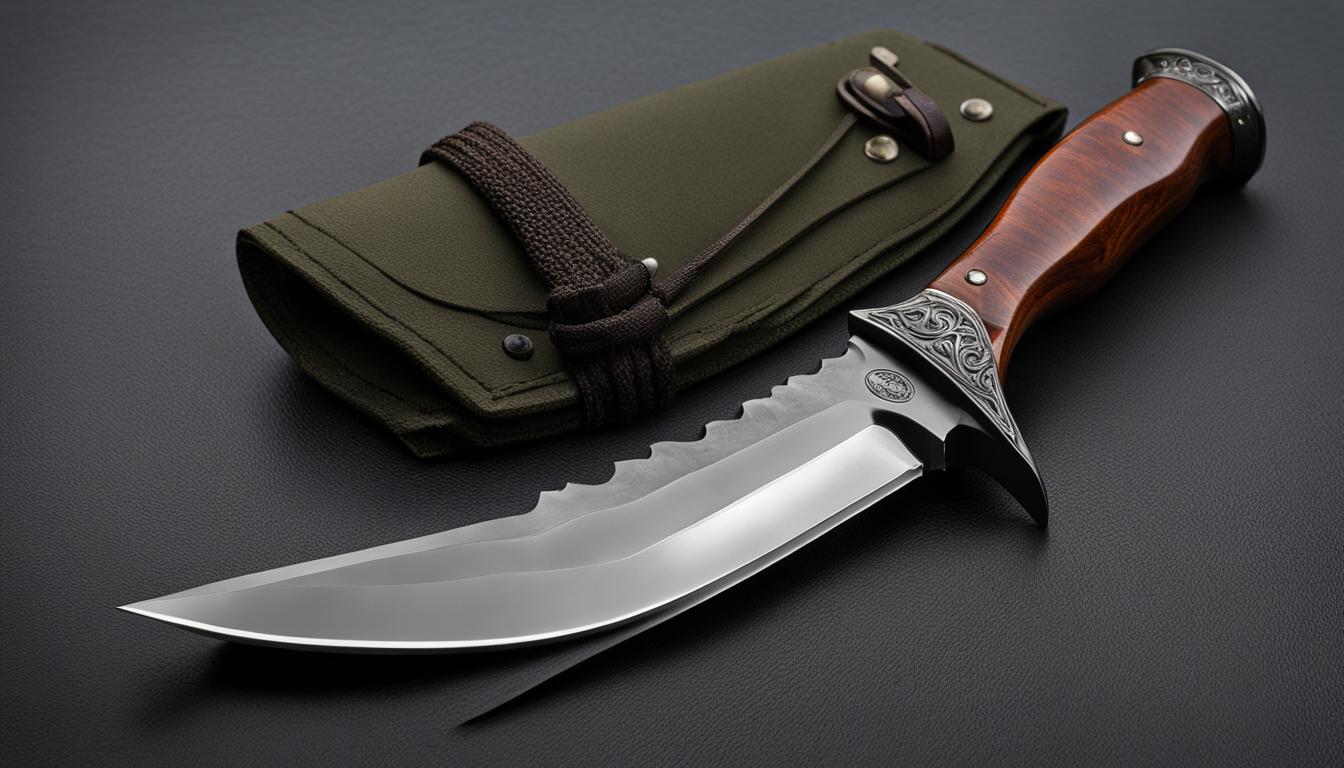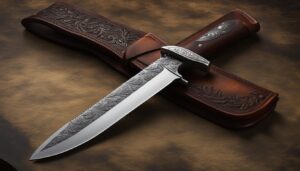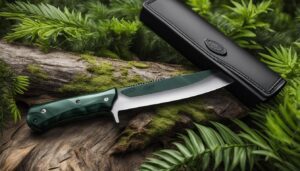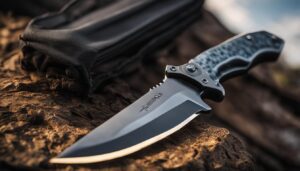As an avid hunter, I understand the significance of having the right tools for the job. When it comes to hunting knives, weight and balance factors are key considerations that can make all the difference in performance and precision. In this article, I will delve into the importance of these factors and how they can enhance your hunting experience.
When it comes to hunting knives, achieving proper balance is crucial for optimal performance and user comfort. A well-balanced knife allows for greater control and maneuverability, reducing hand fatigue and enhancing the overall cutting experience. The balance of a knife also contributes to its stability and safety, minimizing the risk of accidents. Additionally, the balance of a knife impacts its cutting efficiency, allowing for smooth and efficient cutting motions.
Key Takeaways:
- Weight and balance factors greatly influence the performance of hunting knives.
- A well-balanced knife enhances control, maneuverability, and reduces hand fatigue.
- Proper balance contributes to stability and safety, minimizing the risk of accidents.
- The balance of a knife directly impacts its cutting efficiency.
- Consider different ideal balances for various knife types and personal preferences when selecting a hunting knife.
Control and Maneuverability: The Benefits of Proper Balance
A well-balanced hunting knife enables greater control and maneuverability during use. The balance point of a knife should be located where the blade meets the handle, creating an even distribution of weight. This balance allows for precise movements, reduces hand fatigue, and enhances the overall cutting experience. With proper balance, hunters can have better control over their knife, making it easier to handle in different hunting scenarios.
When a hunting knife is properly balanced, it becomes an extension of the hunter’s hand, offering seamless control and maneuverability. The weight distribution allows for more precise movements, whether it’s making precise cuts or skinning game. This enhanced control enables the hunter to adapt quickly to changing situations in the field, ensuring a more successful hunt.
In addition to control, proper balance also reduces hand fatigue. Hunting can be physically demanding, and having a well-balanced knife can make a significant difference in the comfort and endurance of the user. By reducing the strain on the hand and wrist, hunters can maintain their focus and accuracy for longer periods, without experiencing discomfort or fatigue.
Overall, the benefits of a well-balanced hunting knife are evident in the enhanced control and maneuverability it offers. By considering weight and balance factors when selecting a knife, hunters can optimize their performance and reduce hand fatigue, ultimately improving their overall hunting experience.
Quotes:
“Having a well-balanced hunting knife is like having an extra set of reliable hands in the field. It allows for precise control and effortless maneuverability, making the hunting experience more enjoyable and efficient.” – Experienced hunter
Table: Comparison of Balance Points for Different Hunting Knife Types
| Knife Type | Ideal Balance Point |
|---|---|
| Chef’s Knife | Forward balance point for rocking motions and ease of cutting |
| Fillet Knife | Rearward balance point for better control and precision in filleting fish |
| Throwing Knife | Neutral balance point for consistent flight and accuracy |
Stability and Safety: The Role of Balance
When it comes to hunting knives, stability and safety are of utmost importance. A well-balanced knife not only feels more stable in the hand but also helps to minimize the risk of accidents during use. By achieving the right balance, hunters can focus on their target without worrying about the knife tipping or wobbling, ensuring a safer hunting experience.
Having a balanced hunting knife provides a sense of confidence and control during various cutting tasks. Whether it’s dressing game or preparing campsite essentials, a stable knife allows for precise and controlled movements. This stability not only enhances the overall cutting experience but also minimizes the chances of slips or mishaps that could lead to injuries.
Furthermore, a balanced knife promotes safer handling by reducing the likelihood of hand fatigue. When a knife is properly balanced, the weight is evenly distributed, allowing for prolonged use without excessive strain on the hand and wrist. This fatigue reduction is especially crucial during long hunting trips or extended periods of field dressing where precision and concentration are essential.
By prioritizing stability and safety through proper balance, hunters can minimize risks and focus on what matters most – the hunt itself. So next time you’re selecting a hunting knife, remember to consider its balance as a vital factor for a safer and more enjoyable hunting experience.

Table: Ideal Balance Points for Different Knife Types
| Knife Type | Ideal Balance Point |
|---|---|
| Chef’s Knife | Slight forward balance for rocking motions |
| Fillet Knife | More rearward balance for control and precision |
| Throwing Knife | Neutral balance for consistent flight and accuracy |
When it comes to different knife types, the ideal balance points may vary based on their intended use. A chef’s knife benefits from a slight forward balance, allowing for efficient rocking motions when chopping vegetables or slicing through meats. On the other hand, a fillet knife requires a more rearward balance to offer better control and precision while delicately filleting fish. Meanwhile, throwing knives should have a neutral balance to ensure consistent flight and optimal accuracy. Understanding the ideal balance point for each knife type is crucial in optimizing its performance and meeting specific user needs.
In summary, balance plays a vital role in the stability and safety of hunting knives. A well-balanced knife enhances stability, reduces the risk of accidents, and promotes safer handling. By considering the ideal balance points for different knife types and personal preferences, hunters can select the right knife to ensure a secure and enjoyable hunting experience.
Cutting Efficiency: Enhancing Performance with Balance
When it comes to hunting knives, achieving proper balance is not just about comfort and stability; it also directly impacts cutting efficiency. A well-balanced knife allows for smooth cutting motions, reducing effort and maximizing performance in the field.
One of the key benefits of a balanced hunting knife is its ability to facilitate smooth cutting motions. When the weight is evenly distributed along the blade, it ensures that the force applied during cutting is consistent and efficient. This translates into cleaner and more precise cuts, making the knife highly effective for a variety of hunting tasks.
Reducing effort is another advantage of a well-balanced knife. With the weight properly distributed, the knife becomes easier to control and maneuver. This means less strain on the hand and wrist, allowing hunters to make quick, accurate cuts with minimal effort. Whether it’s field dressing game or preparing campfire meals, a balanced knife significantly improves efficiency and reduces fatigue.
Ultimately, balance is an essential factor to consider when selecting a hunting knife. By prioritizing cutting efficiency, smooth cutting motions, and reducing effort, hunters can ensure they have a tool that enhances their performance in the field. So whether you’re an avid hunter or a novice exploring the world of hunting, don’t underestimate the importance of balance in your choice of knife.
Table: Comparing Cutting Efficiency of Different Balance Types
| Balance Type | Cutting Efficiency |
|---|---|
| Forward Balance | Allows for rocking motions and ease of cutting through various ingredients. |
| Rearward Balance | Provides better control and precision while filleting fish. |
| Neutral Balance | Ensures consistent flight and accuracy for throwing knives. |
As shown in the table, different balance types are suitable for different knife types, depending on their intended use. A forward balance is ideal for chef’s knives, enabling smooth rocking motions and effortless ingredient preparation. On the other hand, a rearward balance is more advantageous for fillet knives, providing better control and precision when working with fish. For those who enjoy throwing knives, a neutral balance ensures consistent flight and accuracy. Understanding the relationship between balance and cutting efficiency is key to selecting the right hunting knife for your specific needs.
Different Knife Types, Different Balances: Finding the Right Fit
When it comes to selecting a hunting knife, considering the balance is essential for optimal performance. Different knife types may have varying ideal balances depending on their intended use and design. Finding the right balance for a particular knife type is key to maximizing its efficiency and meeting the specific needs of the user.
For example, a chef’s knife, which is commonly used in the kitchen for various cutting tasks, typically benefits from a slight forward balance. This balance allows for easy rocking motions and enhances cutting through different ingredients with precision. By having the weight slightly forward towards the blade, chefs can maintain greater control and maneuverability.
On the other hand, a fillet knife, which is commonly used for filleting fish, may have a more rearward balance. This rearward balance provides better control and precision when working with delicate fish fillets. The balance allows the knife to glide smoothly through the flesh, ensuring clean cuts and minimizing wastage.
Aside from these examples, there are other knife types with their specific ideal balances. Throwing knives, for instance, require a neutral balance to ensure consistent flight and accuracy. This balance allows the knife to rotate properly during throwing motions, resulting in improved performance during target practice or competitions.
Table 5: Ideal Balances for Different Knife Types
| Knife Type | Ideal Balance |
|---|---|
| Chef’s Knife | Slight forward balance |
| Fillet Knife | Rearward balance |
| Throwing Knife | Neutral balance |
| [Other Knife Type] | [Ideal Balance] |
Personal preference also plays a significant role in selecting the right knife balance. Some individuals may prefer a slightly forward balance for added power and control, while others may prefer a neutral balance for a balanced feel throughout the knife. Experimenting with different balances and considering personal preferences can help hunters find the perfect fit for their needs.
Overall, understanding the different balances required for various knife types is crucial for selecting the right hunting knife. Whether it’s a chef’s knife, fillet knife, throwing knife, or any other type, finding the ideal balance is key to optimizing performance and precision in the field.
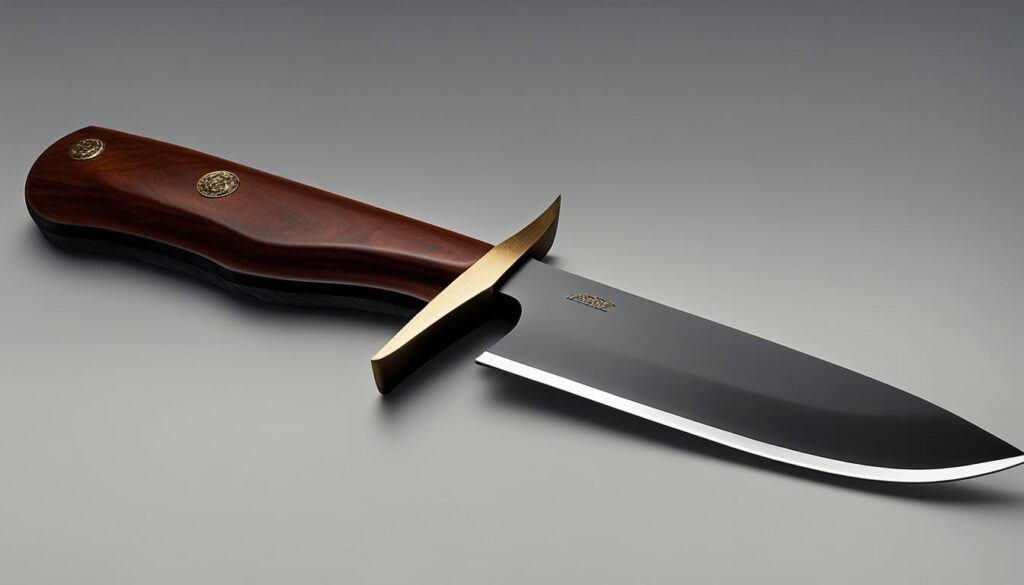

Conclusion
In conclusion, the weight and balance factors of hunting knives are essential for enhancing performance and precision. Achieving proper balance allows for greater control and maneuverability, reducing hand fatigue and improving the overall cutting experience. A well-balanced knife provides stability and safety, minimizing the risk of accidents during use. Additionally, the balance of a knife directly influences its cutting efficiency, making it more effective and reducing the effort required.
It’s important to remember that different knife types may have varying ideal balances based on their intended use. Whether it’s a chef’s knife, fillet knife, or throwing knife, finding the right balance is crucial to optimize performance and meet specific needs. Personal preference also plays a role in selecting the perfect hunting knife.
Consider Weight and Balance Factors
When choosing a hunting knife, it is crucial to consider weight and balance factors. By doing so, hunters can enhance their performance and precision in the field. The right balance enables better control, maneuverability, and reduces hand fatigue. It also ensures stability and safety, minimizing the risk of accidents. Additionally, a well-balanced knife improves cutting efficiency, making it more effective and efficient.
So, whether you’re an avid hunter or a first-time buyer, remember the importance of weight and balance factors when selecting a hunting knife. Take the time to find the right balance that suits your needs and preferences. By doing so, you can enhance your hunting experience and achieve greater success in the field.
FAQ
Why is proper balance important for a hunting knife?
Achieving proper balance in a hunting knife is crucial for optimal performance and user comfort. It allows for greater control and maneuverability, reducing hand fatigue and enhancing the overall cutting experience. Proper balance also contributes to the stability and safety of the knife, minimizing the risk of accidents.
How does proper balance enhance control and maneuverability?
A well-balanced hunting knife enables greater control and maneuverability during use. The balance point of a knife should be located where the blade meets the handle, creating an even distribution of weight. This balance allows for precise movements, reduces hand fatigue, and enhances the overall cutting experience.
How does balance contribute to the stability and safety of a hunting knife?
Balance in a hunting knife provides stability and confidence during various cutting tasks. A well-balanced knife feels stable in the hand, minimizing the risk of tipping or wobbling during use. This enhances safety for the hunter, allowing them to focus on their target without worrying about the stability of the knife.
How does balance impact cutting efficiency?
The balance of a hunting knife directly impacts its cutting efficiency. When properly balanced, it allows for smooth and efficient cutting motions. The weight distribution ensures that the force applied is evenly distributed along the blade, enhancing the knife’s cutting power and reducing the effort required.
Do different knife types require different balances?
Yes, different knife types may have varying ideal balances depending on their intended use. For example, a chef’s knife benefits from a slight forward balance for rocking motions, while a fillet knife may have a more rearward balance for control while filleting fish. Finding the right balance for a particular knife type is essential to optimize its performance and meet the specific needs of the user.
